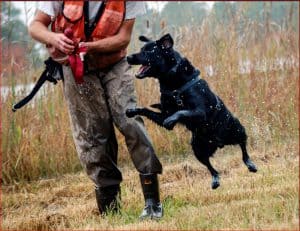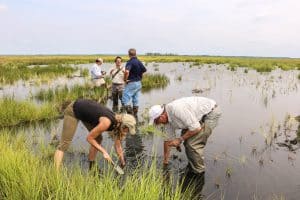Share this article
Another marsh restoration milestone at Blackwater NWR
The U.S. Fish and Wildlife Services hosted a Marsh Resilience Tour August 20 at Blackwater National Wildlife Refuge, providing a look at the largest tidal marsh restoration project at the refuge on Maryland’s Eastern Shore. In the first “thin-layer” project in the Chesapeake watershed, 26,000 cubic feet of sediment was taken from the Blackwater River and spread over 40 acres to elevate the marsh surface. Later the bare restored areas were replanted with 220,000 sprigs of cord grass and other native marsh grasses.

A nutria detector team, Hektor and his handler Carl Dunnock, participate in training program at the Blackwater NWR, outside Cambridge , MD.
©Marnie A. Pepper
The extra eight inches of elevation and new foliage should help extend the life of those acres. Since the refuge founding in 1933, more than 5,000 wetland acres have disappeared at an average of 300 acres annually. Rising sea levels and sinking land contributed to the loss, as has the invasive nutria, a South American rodent whose estimated population reached 35,000 in 1989 at the refuge.
After research by the state wildlife agency and USGS found that marsh vegetation recovered quickly where nutria were excluded, USDA Wildlife Services (WS) joined the Chesapeake Bay Nutria Eradication Project in 2002. Since then a WS team, led by Steve Kendrot from 2002-2014, has removed about 14,000 nutria at the refuge and surrounding areas. Current supervisor Marnie Pepper has developed a corps of canine teams, trained for nutria scat detection, to confirm eradication of the destructive species.
Fortunately, the refuge and its partners, including The Conservation Fund and National Audubon Society, were able to embark on this restoration effort with $2.1 million in Superstorm Sandy relief funding appropriated by Congress and awarded through the National Fish and Wildlife Foundation’s Hurricane Sandy Coastal Resiliency Competitive Grants Program. Those of us in the Mid-Atlantic region are impressed at the steady efforts and progress at this vital regional resource.

More than 200,000 spring of marsh grass were planted on bare, restored acreage, which will improve habitat for at-risk species and the marsh’s ability to withstand changing conditions. ©Dagny Leonard, The Conservation Fund
Blackwater NWR includes more than 28,000 acres of rich tidal marsh, mixed hardwood and pine forests, managed freshwater wetlands, and cropland. The refuge hosts the largest natural population of the Delmarva Peninsula fox squirrel, a large tree squirrel that was recently removed from the endangered species list, and the greatest density of breeding bald eagles on the east coast. It is an important location for migrating and wintering waterfowl in the Atlantic flyway.
For more details see: Marsh Resilience Tour at Blackwater NWR and Chesapeake Bay Nutria Eradication Project.
Wildlife Services is a Strategic Partner of The Wildlife Society.
Header Image: Sediment dredged from the river is applied to wetlands at Blackwater National Wildlife Refuge to help keep up with rising sea levels. ©Middleton Evans, for U.S. Fish and Wildlife Service








